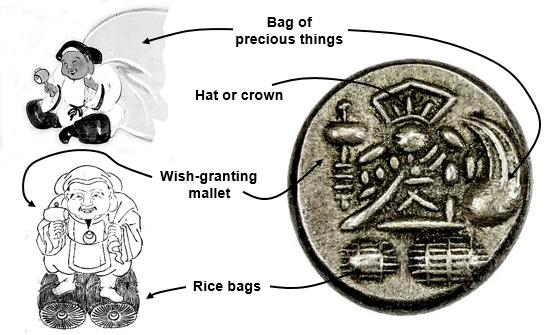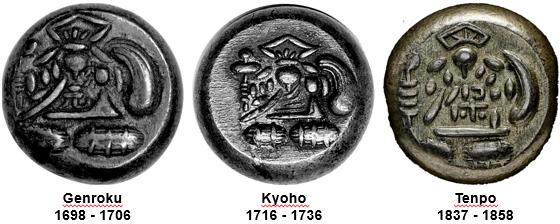Japan Mameita-gin Bean Money with Daikoku (god of plenty) 1601 to 1865
Here is a very interesting segment of numismatics (coin collecting): Japanese mameita-gin, also known as bean money. There are no inscriptions on the coins, so coins are attributed by pattern only. Bean money has a long history, stretching from the late 1500s to the mid 1800s. Values, no surprise, go up as coins get older, but proper attribution and overall condition and eye appeal are paramount.
Mameita-gin are made of silver alloys, some with very low silver content. Percentage of silver ranges from below 15 percent to above 80 percent. Rarely do the coins look like 'standard' silver. They are usually dark. The valuable mameita-gin coins have recognizable patterns on both sides, but some bean-shaped mameita-gins have only minor markings. The lower-value coins are described last on this page.
To understand mameita gin, you must first know about Daikoku, or Daikokuten, a Japanese god of plenty or god of wealth.

He is usually depicted seated on two rice bags, with a wish-granting mallet in his right hand, and a large bag of precious things in his left hand. The 'god of plenty' usually appears on both sides of mameita gin, but sometimes only on one side.
The second thing you must understand are Japanese
eras, or periods of time. There is a good summary on
Wikipedia [Press Here]. Mameita-gin coins appear as early as the Keicho era (1595AD) to as late as the Ansei era (1865AD).
While Daikoku appears on just about all mameita gin, subtle differences in his pattern allow numismatists to assign eras (i.e., date ranges) to individual coins.

There is an excellent page that describes the patterns for each mameita-gin era at
Charm.ru.

Once you have identified the era and estimated the wear and eye appeal of your mameita-gin, you can use the information below to get an approximate idea of value.
EARLY ERAS
Keicho, Genroku, Hoei, Shotoku, Kyoho
worn: $200 US dollars approximate catalog value
average circulated: $400
well preserved: $800
LATE ERAS
Genbun, Bunsei, Tenpo, Ansei
worn: $100 US dollars approximate catalog value
average circulated: $250
well preserved: $500
There are some mameita-gin which have small or large characters on the reverse, called
era designators. Coins with era designators are generally worth more than normal coins with Daikoku on both sides.

Finally, some mameita-gins do not carry fully recognizable Daikoku patterns. These are still interesting and they are still sought by collectors. Values of 'partial pattern' coins (shown to the left, above) vary with size and eye appeal. The smaller coins, 1 to 2 grams, might sell retail for $10 or so. Larger coins, up to 15 to 20 grams, can bring $50 or more.
cqLastNotify
Coin: 21661, Genre: The Sinosphere, Timeline: World
Created (yyyymm): 201711, Last review: 201711
Appearance: Unusual or irregular shape Metallic brown Metallic gray Letters: None
Years: sort: 1601, filter: 1601 to 1865
Image: japan_mameita_gin_ansei.jpg
Tags: tiera slicing curvy god deum swirls diety curves scribble goddess tiarra diamond dei tiara mallot curl crown divine swirl rice lining elliptic genbun twirly bowed slash mameita curly crowning curlicues lined mallets lines tenpo japanise curved gods hammers bar mallet swirly curving japanes dom crowns ovals daikoku deo diamonds japan crowned squiggley slice deus ellipse japanize crossbar deity curve curlycue kyoho bars squiggles slanted gin hammered sqiggles sledge cud swoosh sledgehammer line curls japenese squigle bag japanese squiggly devm outlined outline dios scribbles slant bean blob oval godess hammer lump shotoku tear outlining oblong squiggle




 Once you have identified the era and estimated the wear and eye appeal of your mameita-gin, you can use the information below to get an approximate idea of value.
Once you have identified the era and estimated the wear and eye appeal of your mameita-gin, you can use the information below to get an approximate idea of value.